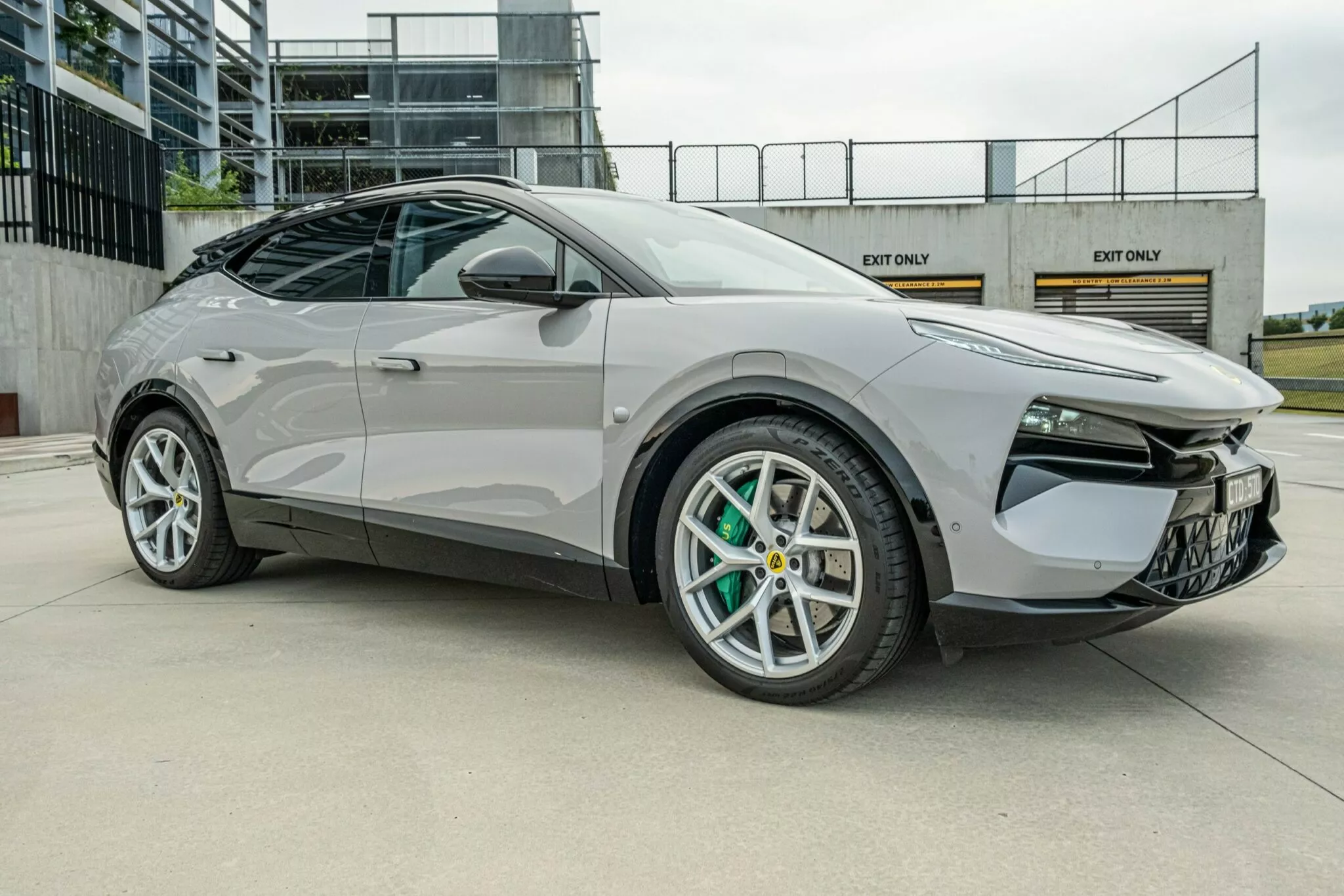The automotive landscape is rapidly evolving. Electric vehicles (EVs) are no longer just a futuristic concept; they are very much the present. As the EV segment matures, many legacy automakers are making bold moves, challenging their own historical identities.
Lotus, a brand synonymous with lightweight sports cars and a “simplify, then add lightness” philosophy, has done precisely this with the Eletre. This all-electric SUV has ignited a mild existential crisis among purists, sparking debate about its place within the esteemed Lotus lineage.
The Eletre’s Controversial Arrival: Challenging Tradition
Since its global unveiling nearly three years ago, the all-electric Lotus Eletre has faced considerable opposition.
The Purist’s Dilemma
Traditional Lotus enthusiasts have voiced strong objections. Their main concern revolves around the brand’s core identity. “How dare a brand focused on lightweight sports cars like Lotus launch a heavy SUV?” they exclaim. Many believe that founder Colin Chapman, known for his relentless pursuit of lightness, would be “turning in his grave.” It’s easy to understand their perspective. Since its inception, Lotus has crafted some of the most refined, driver-focused sports cars ever made. The Eletre represents a dramatic departure from this established ethos.
Learning from Porsche’s Cayenne Success
However, history offers a compelling parallel. When Porsche introduced the Cayenne SUV in 2002, many “real” Porsche purists similarly lamented the end of the brand’s authenticity. Yet, today, countless 911 aficionados who initially hated the Cayenne likely own one as their daily driver. More importantly, the immense success of the Cayenne provided Porsche with the crucial financial resources it desperately needed. These funds helped to sustain and further develop its iconic sports car lineup.
In a similar vein, dismissing the Eletre simply because it deviates from Lotus’s traditional lightweight sports car image would be shortsighted. It would mean overlooking one of the very finest luxury SUVs currently available. After extensive time with the Eletre, it is clear that it represents an important and necessary evolution for the Hethel-based manufacturer. The automotive world is changing, and brands that fail to adapt are destined to fall behind.
Key Specifications: The Eletre S in Detail
The Lotus Eletre is a substantial electric SUV, offering impressive performance and dimensions.
Quick Facts: 2025 Lotus Eletre S
- Model: 2025 Lotus Eletre S
- Starting Price: AU$229,990 (approximately $148,900 USD)
- Dimensions:
- Length: 5,130 mm (201.9 in.)
- Width: 2,019 mm (79.4 in.)
- Height: 1,636 mm (64.4 in.)
- Wheelbase: 3,019 mm (118.8 in.)
- Curb Weight: 2,595 kg (5,720 lbs)
- Powertrain: Dual electric motors / 112 kWh battery
- Output: 603 hp (443 kW) / 524 lb-ft (710 Nm) combined
- 0-62 mph (0-100 km/h): 4.5 seconds
- Transmission: Single speed
- Efficiency (as tested): 21.4 kWh/100 km
- On Sale: Now
Genesis and Model Variants: The Eletre’s Development
The Eletre’s journey from concept to production was a deliberate process, influenced by strategic shifts within Lotus.
Early SUV Exploration: The APX Concept
The Eletre didn’t emerge entirely unexpectedly. As far back as the 2006 Geneva Motor Show, Lotus unveiled the APX concept. This vehicle represented the brand’s initial attempt to gauge interest in an SUV. While the APX never reached production, it signaled Lotus’s awareness of the potential such vehicles held within the market.
However, serious efforts to launch an SUV truly began in earnest only after the brand became majority-owned by Chinese automotive giant Geely. Geely’s investment and vision provided the necessary resources and strategic direction for this ambitious project.
Three Distinct Versions
Lotus has introduced three distinct versions of the Eletre, each catering to different performance and luxury needs:
- Base Model: The entry point to the Eletre lineup.
- Eletre S: A step up, offering enhanced features and performance.
- Eletre R: The flagship model, delivering monstrous power and ultimate performance.
All three variants are built around the same robust 112 kWh lithium-ion battery pack. The base Eletre and the Eletre S models share a common powertrain. They utilize a pair of electric motors that collectively produce 603 hp (443 kW) and 524 lb-ft (710 Nm) of torque. The range-topping Eletre R significantly ups the ante.
Its powertrain churns out a colossal 905 hp and 726 lb-ft (984 Nm) of torque, making it a true hyper-SUV. The Eletre S model, which was tested, is priced from AU$229,990 (approximately $148,900 USD) in Australia. This pricing strategically positions it between the base model (starting at AU$189,900 or about $122,800 USD) and the high-performance R variant (topping out at AU$279,990 or about $181,100 USD).
Market Positioning and Core Technologies
The Eletre occupies a unique space in the luxury electric SUV market, boasting advanced architecture and premium features.
Unique in the Luxury EV Landscape
While the Eletre carries a substantial price tag, it currently has few direct rivals in terms of its specific blend of luxury, performance, and brand heritage. Competitors such as the Mercedes-Benz AMG EQE53 and the BMW iX M60 (soon to be updated and renamed M70) offer luxury electric SUV experiences.
However, neither quite matches the “specialness” of the Lotus, nor do they come close to its performance capabilities. To find an EV that truly matches the Eletre’s performance, one would need to consider a super-SUV like the Lamborghini Urus, which commands a price tag exceeding AU$400,000 (around $259,000 USD). This pricing comparison highlights the Eletre’s unique value proposition in the high-performance luxury EV segment.
Advanced Electrical Architecture and Chassis Control
All versions of the Eletre are built upon an advanced 800-volt electrical architecture. This sophisticated system enables ultra-rapid 350 kW DC fast charging, allowing for quick replenishment of the battery. Standard features across the lineup further underscore the Eletre’s engineering prowess. These include adjustable air suspension for adaptable ride comfort and height, Continuous Damping Control (CDC) dampers for dynamic handling, and torque vectoring by braking for enhanced cornering agility.
Beyond its technical specifications, the Eletre also boasts a flamboyant exterior and interior design. These aesthetic elements are truly distinctive and arguably unmatched by anything outside of high-end Italian marques.
A World-Class Interior: Luxury Meets Technology
The cabin of the Eletre is a standout feature, blending exquisite design with cutting-edge technology to create a truly special environment.
Exquisite Design and Premium Materials
The Eletre’s interior is genuinely beautiful, a quality not easily found in many modern SUV cabins. While many competitors offer functional spaces with premium materials and extensive equipment, the Lotus cabin instills a profound sense of specialness. The design, material choices, and attention to detail elevate the experience.
Driver Interface: Steering Wheel and Displays
The steering wheel is a particular highlight. While photographs might suggest an unconventional or overly dramatic shape, in person, it resembles a finely crafted piece of jewelry. Its size is perfect, and it’s clad in plush grey leather, accented by a metallic 12 o’clock marker. Rocker switches on each side of the wheel control most functions, including music settings and driver-assistance systems. These controls require a brief learning curve but quickly become intuitive.
However, not everything is entirely flawless. Unlike many EVs that offer paddle shifters for regenerative braking, the Eletre uses its left paddle to adjust the level of brake regeneration, and the right to cycle through different drive modes. The digital gauge cluster, a slim 12.6-inch display integrated into the dashboard, feels somewhat modest and less integrated compared to the rest of the cabin. It might be perceived as a slight afterthought.
Crucially, important driving details are also projected onto a large 29-inch head-up display, providing comprehensive information without distracting the driver.
Infotainment System: Seamless and Powerful
The top of the dashboard itself is a work of art. It features separate panels for the driver and passenger sides, seamlessly joined by intricate and infinitely configurable ambient lighting. This creates a visually stunning centerpiece. A large 15.1-inch infotainment display dominates the central console. Its software operates intuitively, similar to a modern tablet, drawing inspiration from Tesla and other leading EVs.
This system is powered by not one, but two Qualcomm Snapdragon 8155 chipsets. It also utilizes Unreal Engine 5, resulting in staggeringly detailed graphics and exceptionally fast response times. It offers what is arguably one of the most seamless infotainment experiences available today.
Despite its impressive performance, the system can initially feel overwhelming due to the sheer volume of settings and menus. This might deter less tech-savvy buyers. However, with a little time and familiarity, the interface becomes very natural to navigate. All climate settings are integrated into the screen, as are controls for the ventilated, heated, and massaging front seats. Both wireless Android Auto and Apple CarPlay are seamlessly supported, ensuring excellent smartphone integration.
Attention to Detail and Minor Concerns
Lotus’s meticulous attention to detail is evident throughout the cabin. Virtually every surface is clad in expensive-looking leather or Alcantara, imbuing the Eletre with a distinctly premium feel. Specific design elements like the brass-colored shifter and temperature controls, as well as the elegantly exposed speaker grilles on the front doors, add unique touches. The small screen on the passenger side is also a thoughtful addition.
One minor concern noted during testing was the condition of the seat bolsters. The driver’s side thigh bolster showed worrying signs of wear and deep creases in the leather, despite the test vehicle being only a few months old. While this could be attributed to the rigorous use by automotive journalists or other purposes during its short life, it suggests a potential area for long-term durability observation.
Space and Comfort: Prioritizing Passenger Experience
Beyond the front cabin, the Eletre excels in providing a spacious and comfortable environment for all occupants, particularly those in the rear.
Exceptional Rear-Seat Comfort
As a family-oriented SUV, Lotus has paid significant attention to the experience of rear-seat passengers. The second-row seats are exceptionally comfortable, offering ample legroom and headroom for even taller occupants. This ensures a relaxing journey for all. Additionally, the backrests are electrically adjustable, allowing passengers to find their ideal seating position. These seats also feature both heated and ventilated functions, controllable via a dedicated touchscreen located on the back of the center console.
Advanced Climate Control
Further enhancing comfort, the Eletre boasts quad-zone climate control. This means that not only can four distinct sections of the cabin be set at different temperatures, but the fan speeds for each zone can also be adjusted independently. This level of climate customization ensures that all occupants can enjoy their preferred microclimate within the vehicle.
Eletre S Exclusive Features and Options
The Eletre S model includes several key features that are not found on the base variant. These include stylish illuminated metal tread plates at the door sills, an active rear wing for enhanced aerodynamics and visual flair, and convenient soft-close doors. The Eletre S also comes standard with a powerful 23-speaker KEF Reference audio system, promising an immersive sound experience. It rides on 22-inch wheels as standard, with the option to upgrade to larger 23-inch ones.
For enhanced braking performance, the standard six-piston front brake calipers can be optionally upgraded to 10-piston calipers paired with carbon ceramic discs. Interior customization extends to seating, with options for black, white, gold, red, and green leather upholstery.
Ample Cargo Capacity
Practicality is also a strong suit for the Eletre. It offers a generous 688 liters (24.2 cubic feet) of cargo space in the trunk. This capacity expands significantly to 1,523 liters (53.7 cubic feet) when the rear seats are folded down, providing ample room for luggage and gear. Lotus has also incorporated a small storage area in the “frunk” (front trunk), though it is primarily designed to accommodate a thick charging cable rather than substantial luggage.
Driving Dynamics: Can it Drive Like a Lotus?
The ultimate test for the Eletre is how it performs on the road, particularly given Lotus’s performance heritage.
Surprising Acceleration Delivery
Initial expectations about EV acceleration are often instant, neck-snapping torque. However, the Eletre S delivers its performance in a more nuanced way. While Lotus claims a 0-62 mph (0-100 km/h) time of 4.5 seconds, the power and torque are not deployed instantly from a standstill. This results in a somewhat sedate launch off the line. As speeds increase, the acceleration builds noticeably.
It begins to pull much harder after approximately 90 km/h (56 mph), similar to how an Audi RS e-tron GT transitions into its second gear. Interestingly, the Eletre only has a single-speed transmission. This suggests that software trickery is likely responsible for this gradual surge in acceleration. The Eletre S consistently matched its claimed 4.5-second sprint time in testing, even with decreasing battery levels.
It is expected that the more powerful Eletre R, with its 2.9-second 0-62 mph time, would deliver the instant, brutal acceleration typical of comparable high-performance EVs.
Lotus-Like Steering and Agile Handling
Lotus models have historically been lauded for their precise and communicative steering. The good news is that the Eletre largely lives up to this legacy. While its substantial curb weight of 2,595 kg (5,720 lbs) is undeniable, the vehicle’s handling remarkably masks much of this mass. Drivers could easily be fooled into thinking it’s significantly lighter than its official figure suggests.
The steering is perfectly weighted, providing excellent feedback and quick response to driver inputs. The Eletre dances around corners in a manner uncharacteristic for an SUV of its size.
No doubt aiding in this extraordinary handling are the massive Pirelli P Zero tires: 275/40 at the front and 315/35 at the rear. Even when pushed hard on public roads, the Eletre maintained remarkable neutrality and composure, resisting both understeer and oversteer.
Mighty and Smooth Braking
The braking performance of the Eletre is genuinely impressive. Even with the standard six-piston calipers (rather than the optional ten-pots and carbon ceramic discs), the test car stopped from 62 mph in just 2.6 seconds. This matches the stopping time recorded in a BMW M4 Competition, a testament to its powerful deceleration.
Beyond sheer stopping power, the brakes offer excellent feel. They are smooth and predictable, and the transition between regenerative braking and friction braking is imperceptible, providing a natural and confidence-inspiring pedal feel.
Regenerative Braking and Drive Modes
Several levels of regenerative braking can be toggled via the left paddle shifter, allowing drivers to customize the energy recovery intensity. However, a notable omission is a one-pedal driving mode. This feature, commonly found in many more affordable EVs, allows for significant deceleration simply by lifting off the accelerator pedal. While Lotus could have easily incorporated this, for reasons unknown, they chose not to.
The Eletre offers multiple driving modes to suit various conditions and preferences, including Individual, Sport, Tour, Range, and Off-Road. These settings allow for independent adjustments of the air suspension and the vehicle’s ride height. Crucially, regardless of the selected ride height or driving mode, the ride remains plush and comfortable. This is a significant achievement for a large EV, distinguishing it from many competitors that often offer a harsher ride.
Areas for Improvement: Room for Refinement
While the Eletre is impressive, there are a few areas where it could be refined.
LiDAR Sensor Integration and Driver Assistance
One of the most talked-about features of the Eletre is its use of several LiDAR sensors, including one that emerges from the roof and two that deploy from the front fenders. In some markets, these are standard. However, in Australia, they are only available as part of an AU$8,000 (approximately $5,200 USD) Highway Assist Pack.
Lotus notes that only about 20% of buyers are opting for this package. A frustrating consequence is that vehicles without the LiDARs do not receive any form of active lane centering, only a traditional radar cruise control system. At the Eletre’s price point, active lane centering is a must-have feature and its absence in the standard configuration is a notable oversight.
Efficiency and Headlight Issues
Efficiency is not the Eletre’s strongest suit. While it boasts a quoted range of 500 km (311 miles), this figure is realistically achievable primarily during steady cruising. When driven more spiritedly, the range drops closer to 400-450 km (248-280 miles). While sufficient for most daily driving, this range isn’t particularly impressive considering the vehicle carries a large 112 kWh battery pack. More efficient EVs with similar battery sizes can achieve greater distances.
Another issue observed relates to the Eletre’s matrix LED headlights. While designed to intelligently blank out segments to avoid dazzling oncoming traffic, the system in the tested vehicle appeared to be overly sensitive. The lights were almost continuously cutting lighting segments in and out, seemingly mistaking reflectors on other cars, or even brightly lit street signs, for opposing headlights.
This resulted in a distracting “disco-like” flashing effect, particularly noticeable on residential streets with many parked cars. For an EV in this price bracket, such an obvious issue should ideally have been addressed before production commenced.
Verdict: A Superb Electric SUV that Defies Expectations
Despite the initial controversy and minor imperfections, the Lotus Eletre stands as a truly superb electric SUV.
A Bold Statement in the Premium Market
Those who have not experienced the Eletre firsthand may continue to voice their opposition to a large, heavy, electric SUV bearing the Lotus badge. However, the fact remains that the car itself is exceptionally well-executed. It boasts a bold and futuristic aesthetic that undeniably turns heads on the road. Its plush and luxurious interior sets it apart, offering an ambiance unlike anything else in the market.
Combined with its great driving dynamics, the Eletre ticks numerous boxes for a discerning buyer. It stands out significantly in the increasingly crowded premium SUV market.
For buyers who wish to avoid the more obvious choices from established rivals like Porsche or Lamborghini, the Lotus Eletre presents a compelling and distinctive alternative. Its unique blend of luxury, performance, and cutting-edge technology may be reason enough to give it a serious second look.






